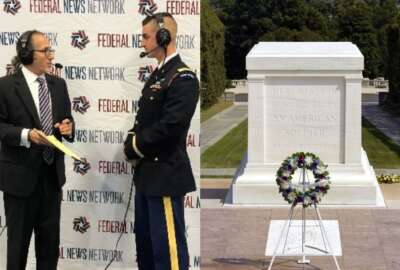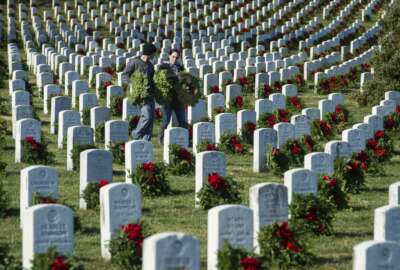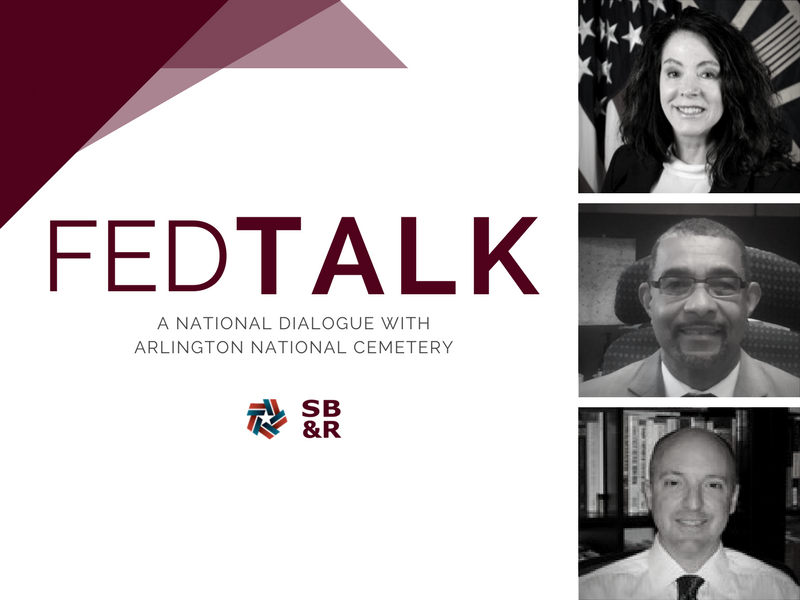
A small step for man, a giant leap for those wanting to honor war dead
Federal Drive with Tom Temin caught up with the commander of the soldiers who guard the Tomb of the Unknown, 1st Lt. Andrew Katz at the Association of the U.S. Army...
Best listening experience is on Chrome, Firefox or Safari. Subscribe to Federal Drive’s daily audio interviews on Apple Podcasts or PodcastOne.
The Tomb of the Unknown Soldier – actually there are three soldiers at rest there – is one of the most hallowed sites in the country. It’s also one of the most popular visitor attractions at Arlington National Cemetery. Next month, the cemetery will mark an important date. For details, Federal Drive with Tom Temin caught up with the commander of the soldiers who guard the Tomb of the Unknown, 1st Lt. Andrew Katz at the Association of the U.S. Army Conference in Washington last week.
Interview transcript:
Andrew Katz: This November, we have the opportunity to commemorate the 100 years since the internment of the World War I Unknown, on Nov. 11, 1921. Originally designed to be a place of remembrance, a place of mourning for the family members who lost loved ones during World War I, this historic site in Arlington National Cemetery has grown to become not only the heartbeat of Arlington National Cemetery, but a special place where two countries can come together. Aligned countries who have fought in battle to honor those who have gone in the line of duty.
Tom Temin: Now the contents of the tomb, has that changed over the years? Are there more unknowns there than the original one from World War I?
Andrew Katz: Yes, originally in 1921, the first unknown soldier was laid to rest. Later in 1958 America interred an unknown service member from World War II and from the Korean War. And finally, in 1984, we interred the Vietnam Unknown. However, 14 years later in 1998, through forensics, we were actually able to identify the Vietnam Unknown as 1st Lt. Michael J. Blasey. His remains were returned to his family where he was laid to rest in his hometown of St. Louis, Missouri. So there were four, there are now three unknown service members buried on the plaza at the Tomb of the Unknown Soldier. However, those service members represent more than just themselves. They represent the thousands of service members whom we were not able to pay our respects to as a nation, the many service members that we were not able to identify.
Tom Temin: And to commemorate the centennial of this what will specifically happen?
Andrew Katz: This November on the 9th and the 10th Arlington National Cemetery is hosting a flower ceremony, where visitors the cemetery will have a once in a lifetime opportunity to enter onto the plaza the Tomb of the Unknown Soldier to lay a flower at these headstones. With your flower, you are showing your reverence, a sign of connectivity to our mission, the tomb guard mission at the Tomb of the Unknown Soldier to continuously render honors to the service members who have come before us. They gave more than just their lives. They gave their identities and in doing so, they created this place where we could celebrate those who have come before us.
Tom Temin: And we should note you’re speaking without notes. Are you speaking from memory or you’re speaking from Andrew Katz?
Andrew Katz: Yes, sir – as a tomb guard and now as a sentinel, it is our duty to be stewards of not only the profession of arms, but also stewards and representation of Arlington National Cemetery. So the history of the interments of the unknowns, as well as the history of the cemetery, and the history of the guards that have protected them, is an important part of our mission. And it’s our honor, our privilege to be able to tell that story to the millions of visitors that pass through Arlington National Cemetery every year.
Tom Temin: Sure, and without saying, “um,” which I wish more my guests were able to do. But this idea of being able to step onto the plaza close to the stones themselves, the markers, that’s something ordinarily that never happens. In other words, that’s a sacrosanct area all other times.
Andrew Katz: That is correct. That is where tomb guards have walked continuously since the first guard in 1925, the first military guard in 1926, and then in 1937, when the first 24-hour guard was posted. Since that time, there has been a guard continuously serving rain or shine. No matter the weather, no matter the season at the Tomb of the Unknown Soldier. It has been closed off, surrounded by chains and rails that enclose this eternal resting place of these three unknown service members, all of whom were presented the Medal of Honor for their service. This flower ceremony affords all visitors the opportunity to share in this honor of rendering honors to our nation’s unknown war dead.
Tom Temin: And those that serve as guards, this 24/7 sentinel that happens there, are they only Army or is this a multi-service situation?
Andrew Katz: Yes, sir. This is been a privilege that the United States Army has been able to hold and maintain since the first military guards in 1926. Preceeded by the 3rd Cavalry Regiment, the Old Guard took over the right to guard the unknown on the 6th of April 1948. And the old guard the third Infantry Regiment has been conducting this mission ever since.
Tom Temin: And we are speaking with Army 1st Lt. Andrew Katz, who is commander of the guards of the Tomb of the Unknown Soldier. And when you join the Army was this what you had in mind?
Andrew Katz: No sir, I wanted to be an infantry platoon leader. I branched infantry. I went down to Fort Benning to complete infantry basic officer course, Ranger School, airborne school, in hopes to be an infantry platoon leader. My first duty station was in Savannah, Georgia, was at Fort Stewart, where I was assigned to be a rifle platoon leader and then a reconnaissance platoon leader. Following those assignments, the opportunity to come and serve the 3rd Infantry Regiment presented itself and I realized very quickly the opportunity to grow as an individual and as a leader. The attention to detail, the time and task management, as well as the teamwork and the individual responsibility that’s trained here, were life lessons that I knew I couldn’t live without. And that is what serving in the 3rd Infantry Regiment has afforded me the opportunity to do.
Tom Temin: And what are the essential requirements of being a guard? I mean, we see what they do, and it’s quite impressive. And they never make a mistake so far as I’m aware. What does it take?
Andrew Katz: It takes resilience. It takes determination. And it takes a passion and an understanding for what it is that we are doing, and more importantly, who it is that we are protecting. We have soldiers as young as 18-, 19-year-old infantry soldiers, culinary specialists, medics, motor transport operators, all different [Military Occupational Specialties] from all different backgrounds. And we instill an understanding and a reverence in all of our teammates that’s important to continue in training as a tomb guard. And that understanding breeds those character attributes that I mentioned previously, that ultimately lead a tomb guard to graduate from training and become a tomb sentinel.
Tom Temin: And in addition to all those qualities, it also takes a lot of practice, too, doesn’t it? I mean, rehearsal?
Andrew Katz: Yes. So while we are on duty, we’re on duty 24/7. That does provide us the opportunity – the cemetery is open from the hours of 8 a.m. to 5 p.m. Outside of those hours, we maintain a continuous guard. While the public is outside of the cemetery, it does afford us the opportunity to conduct rigorous and reoccurring training. Our three main pillars of training as tomb guards are ceremonial performance of our four main missions, which are the guard, the changing of the guard, Army wreath laying ceremonies, and full honors wreath laying ceremonies. The two main other aspects of tomb guard training are uniform maintenance and production, the ability to assemble, curate, and reproduce your uniform so that every single time you have the opportunity to guard the unknowns, to go out and conduct our sacred duty, you are doing so to the best of your ability, and you are the absolute best representation of not only the United States Army, but the United States military that you could be. And the final pillar, of course, is the tomb knowledge. Ssome of the history that we’ve shared today, some of the facts that we’ve talked about – having that keen understanding, and that awareness of the history that we are a part of, and the history and the legacy that we’re honoring, is the third pillar to tomb guard training. And once you are able to master those three pillars, and you complete a series of five tests, you will go from tomb guard to sentinel. And as a sentinel, you are entrusted with producing the future of our platoon, the future of tomb guard training.
Tom Temin: Got it? And in those night hours when nobody is there from the public. Is there someone watching so that the continuous process of perfection and maintaining standards continues?
Andrew Katz: Absolutely.
Tom Temin: I mean, if you’re going to misstep, it’s better to do it at 2 a.m. and figure out how to practice around that than it is at noon.
Andrew Katz: Absolutely, the continual guard is always present the Tomb of the Unknown Soldier, and it’s a team effort. Training is never done alone. Training is always under the guise of watchful sentinels, who have been entrusted to maintain and uphold the standard. And as a sentinel, that is the greatest honor that I could ever have as a trainer to be able to ensure that the future of this platoon that future generations of Americans and visitors to our national cemetery will have the opportunity to witness what I witnessed in 1997, when my parents brought me at the age of three to Arlington National Cemetery, to see the changing of the guard. And what I saw on that day as a three year old is the exact same image, the exact same ceremony that we are still asked to perform today and we still have the honor of performing today.
Tom Temin: And as the commander of the whole kit and caboodle, do you ever do a shift yourself just to kind of stay sharp?
Andrew Katz: I have completed shifts, I went through a similar training program to most of my soldiers. As the administrative and the operational leader of the platoon, I do not have the same opportunities to go through all the same training programs. But going through and learning the guard shift the changing of the guard, and the wreath laying ceremonies, it is an experience and an Army training program that I do not think can be rivaled. The severity and the attention to detail that tomb sentinels have for their job is simply admirable. And I think we can all learn from the work ethic and the dedication of these incredible service members.
Tom Temin: And what are your hopes for the future of your Army career?
Andrew Katz: This will complete my platoon leader time. After this will be company command. That’s one of the big things I look forward to.
Tom Temin: So you’re gonna stick around?
Andrew Katz: I’ll be around for a little bit, absolutely.
Copyright © 2025 Federal News Network. All rights reserved. This website is not intended for users located within the European Economic Area.
Tom Temin is host of the Federal Drive and has been providing insight on federal technology and management issues for more than 30 years.
Follow @tteminWFED






